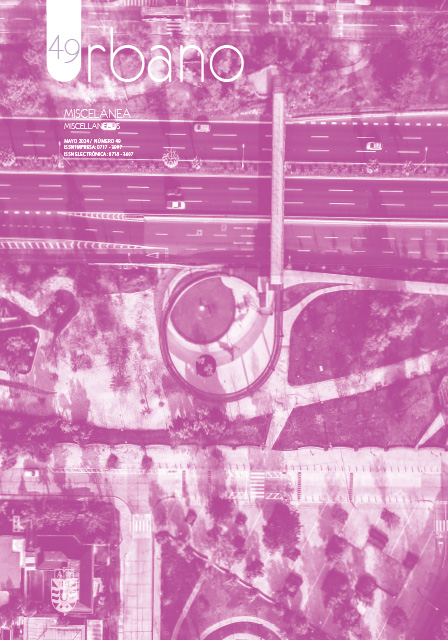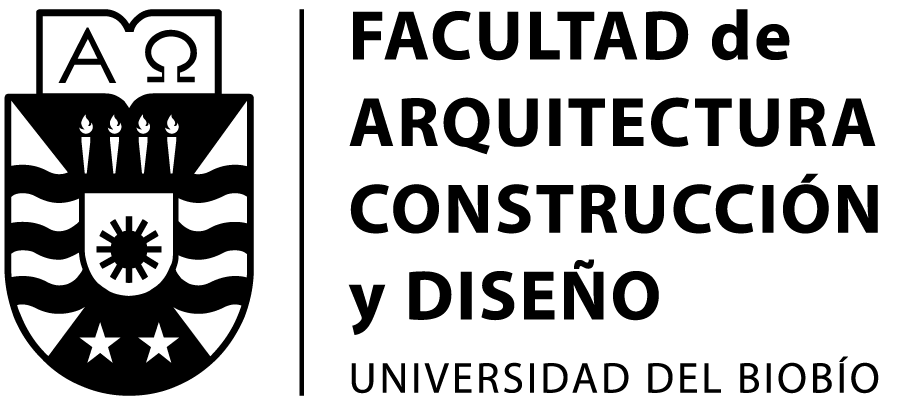Producing peripheries: morphology and habitability in the conurbations of Cuenca, Ecuador
DOI:
https://doi.org/10.22320/07183607.2024.27.49.06Keywords:
urban morphology, habitability, periphery, urban sprawl, intermediate cityAbstract
The expansion of Latin American intermediate cities has left irregular and discontinuous occupation patterns in their peripheral territories. In appearance, the configurations of the urban edges do not have relevant differences. In fact, each morphological structure is heterogeneous and has its own behaviors, different occupation motivations, and diverse resulting consolidated models. In Cuenca, Ecuador, these diffuse zones between the urban and rural limits are marked by segregation dynamics and dependence on the consolidated center and have the lowest quality-of-life indexes in the city. In this context, the objective of the research was to find a possible relationship between the types of peripheral morphologies and the levels of urban habitability of four city urban centers, using a quantitative methodological design with a two-stage correlational scope. Initially, urban morphologies were classified, and the habitability levels were rated separately, applying independent instruments. Then, the results were cross-checked to describe possible links between variables. The findings highlight significant disparities in habitability between conurbations and define an apparent direct correlation between the two dimensions of analysis.
Downloads
References
ABDELRASHID, D., KHALIFA, A., SERAG, Y., y EL FAYOUMI, M. (2023). Investigating The Common Perceptual Qualities of Urban Morphology and Subjective Wellbeing Scales for Urban Mobility Studies: A Literature Review. Future Engineering Journal, 1(4), 1-14. https://digitalcommons.aaru.edu.jo/fej/
ALCALÁ, L. (2007). Dimensiones urbanas del problema habitacional. El caso de la ciudad de Resistencia, Argentina. Revista INVI, 22(59) 35-68. https://doi.org/10.5354/0718-8358.2007.62133
ALEXANDER, C. (1977). A pattern language: Towns, Buildings, Constructions. Oxford University Press. https://www.patternlanguage.com
ALEXANDER, E. R., REES, K. D., y MURPHY, P. Y. (1988). Density measures and their relation to urban form. Center for Architecture and Urban Planning. http://dc.uwm.edu/caupr_mono/37 12/1/2024
ÁVILA, H. (2008). Enfoques geográficos en torno a la nueva ruralidad en E. Pérez, M, Farah y H. Cartón de Grammont. La nueva ruralidad en América Latina. Avances teóricos y evidencias empíricas (1a Ed., pp. 103-132). Pontificia Universidad Javeriana. https://www.flacsoandes.edu.ec/sites/default/files/agora/files/1254927167.luciano_martinez_la_descentralizacion_0.pdf
ANANDA, J. (2014). Evaluating the Performance of Urban Water Utilities: Robust Nonparametric Approach? Journal of Water Resources Planning and Management, 9(140) 40-54. https://doi.org/10.1061/(ASCE)WR.1943-5452.0000387
BERGHAUSER, M., y HAUPT, P. (2021). SPACEMATRIX Space, Density and Urban Form. Nai Publishers Netherlands. https://www.researchgate.net/publication/351049141_Spacematrix_-_Space_Density_and_Urban_Form
BERGHAUSER, M., HAUPT, P., BERG, P., ALSTÄDE, V., y HEYMAN, A. (2021). Systematic review and comparison of densification effects and planning motivations. Buildings and Cities, 2(1), 378-401. https://journal-buildingscities.org/articles/10.5334/bc.125
BRAMLEY, G., y POWER, S. (2009). Urban form and social sustainability: the role of density and housing type. Environment and Planning B: Planning and Design, 36(1), 30-48. https://journals.sagepub.com/doi/abs/10.1068/b33129
BRUEGMANN, R. (2005). Sprawl: a compact history. The University of Chicago Press. https://press.uchicago.edu/ucp/books/book/chicago/S/bo3614185.html
CABRERA, N. (2016). Metodología para el diagnóstico y la ordenación de los corredores de crecimiento de ciudades intermedias ecuatorianas: Cuenca como caso de estudio [Tesis de magíster, Universidad de Cuenca]. http://dspace.ucuenca.edu.ec/handle/123456789/25256
CEPAL. (2020). Panorama Social de América Latina. CEPAL. https://repositorio.cepal.org/entities/publication/61652648-a144-413a-bab4-1eae639b3ecf
DEMPSEY, N., BROWN, C., y BRAMLEY, G. (2012). The key to sustainable urban development in UK cities? The influence of density on social sustainability. Progress in planning 77(3), 89-141. https://www.sciencedirect.com/journal/progress-in-planning/vol/77/issue/3
DAVE, S. (2011). Neighborhood Density and Social Sustainability in Cities of Developing Countries. Sustainable Development, 19(3), 189-205. https://doi.org/10.1002/sd.433
DEMPSEY, N., BROWN, C., y BRAMLEY, G. (2012). The Key to Sustainable Urban Development in UK cities? The Influence of Density on Social Sustainability. Progress in Planning, 77, 89-141. 10.1016/j.progress.2012.01.001
DÍAZ, M., y MEDINA, M. (2019). Concepto de Compacidad urbana en el contexto de borde urbano en D. A. Arias-Caicedo, J. J. Castiblanco-Prieto, M. Castillo-de Herrera, M. S. Díaz-Osorio, I. F. Medina-Arboleda, M. Medina-Ruiz, . . . A. Y. Vallejo-Rivas. El borde urbano como territorio complejo. Reflexiones para su ocupación (1a ed., pág. 24). Bogotá: Universidad Católica de Colombia. https://hdl.handle.net/10983/26147
ESPINOZA, A., y GÓMEZ, G. (2010) Hacia una concepción socio-física de la habitabilidad: espacialidad, sustentabilidad y sociedad. Palapa, 5(1) 59-69. https://www.redalyc.org/pdf/948/94820714006.pdf
EWING, R., HAJRASOULIHA, A., NECKERMAN, K., PURCIEL, M., y GREENE, W. (2016). Streetscape Features Related to Pedestrian Activity. Journal of Planning Education and Research, 36(1), 5-15. https://doi.org/10.1177/0739456X15591585
FREIDBERGER, M. (2000). The rural-urban fringe in the late twentieth century. Agricultural History, 74(2), 502-514. https://doi.org/10.1215/00021482-74.2.502
GARCÍA, F. (6 y 7 de junio del año 2016). Morfología urbana en la periferia del siglo XX de Murcia: compacidad y densidad de los tejidos urbanos. [Discurso principal]. VIII Seminario Internacional de Investigación en Urbanismo. Barcelona, España. https://doi.org/10.5821/siiu.6264
GEHL, J. (2010). Cities for People. Island Press.
Gilbert, A. (1997). La ciudad latinoamericana. Siglo XXI. https://www.redalyc.org/articulo.oa?id=67601722
HERMIDA, M., HERMIDA, C., CABRERA, N., y CALLE, C. (2015). La densidad urbana como variable de análisis de la ciudad. El caso de Cuenca, Ecuador. Revista Eure, 41(124), 25-44. http://dx.doi.org/10.4067/S0250-71612015000400002
HERMIDA, M., CABRERA, N., y DURÁN, M. (2023). Crecimiento y urbanización en L. Fuentes, M. Greene, R. Mora (Eds.) Dinámicas urbanas(1a ed., Vol. 1, pp. 12-31). Pontificia Universidad Católica de Chile. https://www.researchgate.net/publication/376112098_Crecimiento_y_Urbanizacion
HOUSTON, D., BOARNET, M. G., FERGUSON, G., y SPEARS, S. (2015). Can Compact Rail Transit Corridors Transform the Automobile City? Planning for More Sustainable Travel in Los Angeles. Urban Studies, 52(5), 938-959. https://www.jstor.org/stable/26146022
INEC (Instituto Ecuatoriano de Estadísticas y Censos). (2014). Estadísticas. http://www.inec.gob.ec/estadisticas/
INGVARDSON, J., y NIELSEN, O. (2018). Effects of new bus and rail rapid transit systems – an international review. Transport Reviews, 38, 96-116. https://www.worldtransitresearch.info/research/6699/
KIM, D., PARK, J., y HONG, A. (2018). The Role of Destination’s Built Environment on Nonmotorized Travel Behavior: A Case of Long Beach, California. Journal of Planning Education and Research, 38(2), 152-166. https://doi.org/10.1177/0739456X16688765
KROPF, K. (2009). Aspects of Urban Form. Urban Morphology, 13(2), 105–120.
https://doi.org/10.51347/jum.v13i2.3949
LIN, J., y YANG, A. (2009). Structural Analysis of How Urban Form Impacts Travel Demand: Evidence from Taipei. Urban Studies, 9(46), 51-67. https://doi.org/10.1177/0042098009106017
MARCHANT, C., RIESCO, M., y MONJE, Y. (2023). Crecimiento y fragmentación del periurbano valdiviano. Efectos del urbanismo neoliberal en una ciudad intermedia del sur de Chile. EURE, 49(147), 1-25. http://dx.doi.org/10.7764/eure.49.147.09
MARTINS, F. y PEREIRA, G. (2022). Produção imobiliária de habitação em Curitibana década de 2010: algumas reflexões. Cadernos Metrópole, 24(53), 311-336. https://doi.org/10.1590/2236-9996.2022-5312
MONTERO, L., y GARCÍA, J. (2017). Panorama multidimensional del desarrollo urbano en América Latina y el Caribe. CEPAL. https://repositorio.cepal.org/entities/publication/f5b33bfe-0c64-4f2f-88a0-0e53b0639727
MORENO, S. (2008). La habitabilidad urbana como condición de calidad de vida. Palapa, 11(7), 47-54. https://www.redalyc.org/pdf/948/94814774007.pdf
MOURATIDIS, K. (2018). Built Environment and Social Well-being: How does urban form affect social life and personal relationships? Cities, 74, 7-20. https://doi.org/10.1016/j.cities.2017.10.020
MUMFORD, L. (2014). La ciudad en la historia: sus orígenes, transformaciones y perspectivas. Logroño: Pepitas de calabaza. Sociología histórica. https://revistas.um.es/sh/article/view/246771/186591
OLIVEIRA, V. M. (2017). Morfologia urbana: diferentes abordagens. Revista De Morfologia Urbana, 4(2), 65–84. https://doi.org/10.47235/rmu.v4i2.7
ORELLANA, D., y OSORIO, P. (2014). Segregación socio-espacial urbana en Cuenca, Ecuador. Analítika: revista de análisis estadístico, 8, 27-38. https://dialnet.unirioja.es/servlet/articulo?codigo=5004620
PAN, H., LI, J., SHEN, Q., y SHI, C. (2017). What Determines Rail Transit Passenger Volume? Implications for Transit-Oriented Development Planning. Transportation Research Part D: Transport and Environment, 57, 52-63. http://www.sciencedirect.com/science/journal/13619209
PESÁNTEZ, M., y CABRERA, N. (2023). Morfología y habitabilidad urbana en el borde de una ciudad intermedia. Caso de estudio Cuenca, Ecuador [Tesis de magister. Universidad del Azuay]. http://dspace.uazuay.edu.ec/handle/datos/13224
PÉREZ, A. (1999). “La construcción de indicadores Bio-Ecológicos para medir la calidad del ambiente natural urbano”. Documento de investigación del Grupo de Calidad Ambiental Urbana. Mérida: Facultad de Arquitectura y Arte de la Universidad de Los Andes. https://docplayer.es/15445317-La-construccionde-indicadores-bio-ecologicos-para-medir-la-calidad-del-ambiente-naturalurbano.html
PRIETO, P., ROMERO, V., MOYANO, A., SOLÍS, E., y CORONADO, J. (2018). Identificación, clasificación y análisis de las formas urbanas en ciudades medias: aplicación a las capitales provinciales de Castilla-La Mancha. Anales de Geografía de la Universidad Complutense, 38(1), 87-112. https://dialnet.unirioja.es/servlet/articulo?codigo=6484433
ROCCA, M., LANCIONI, A., RÍOS, L., DELLACHAUX, A., y SGROI, A. (2013). Expansión urbana en municipios de la provincia de Buenos Aires: avances del proceso y vínculos con las políticas territoriales. Mundo Urbano, 41. http://www.mundourbano.unq.edu.ar/index.php/ano-2013/75-numero-41/243-expansion-urbanaenmunicipios-de-la-provincia-de-buenosaires-avances-del-proceso-yvinculoscon-las-politicas-territoriales
RODAS, A. (2019). La vida social en la vivienda. Fenomenología de la habitabilidad programa habitacional socio vivienda, Guayaquil-Ecuador [Tesis de doctorado. Universidad de Morelos]. http://riaa.uaem.mx/handle/20.500.12055/1173
RUIZ, J., y ROMANO, S. (2019). Mezcla social e integración urbana: aproximaciones teóricas y discusión del caso chileno. Revista INVI, 34(95), 45–69. https://revistainvi.uchile.cl/index.php/INVI/article/view/63073
SALAZAR, C., y ZULETA, B. (2014). La noción de borde en la narrativa urbana. Estudio de caso: Medellín, Colombia. Revista Bitácora Urbano Territorial, 24(2), 31-39.
SCHILLER, G. (2007). Urban infrastructure: challenges for resource efficiency in the building stock. Building Research y Information, 35(4), 399-411. https://doi.org/10.1080/09613210701217171
SEGARRA, G. (2021). Narrativas en la periferia de la ciudad intermedia. El caso de Loja-Ecuador. Revista Eidos, 17, 75–85. https://dialnet.unirioja.es/servlet/articulo?codigo=8489524
TORO, C., VELASCO, V., y NIÑO, A. (2005). El borde como espacio articulador de la ciudad actual y su entorno. Revista Ingenierías Universidad de Medellín, 4(7), 55- 65. https://www.redalyc.org/pdf/750/75004705.pdf
VILLAMIZAR, N. (2014). Bordes urbanos: teorías, políticas y prácticas para la construcción de territorios de diálogo. Bitácora Urbano Territorial, 2(24), 31-33. https://issuu.com/bitacoraurbanoterritorial/docs/bit__cora_24_v2_/1
ZHANG, W., y ZHANG, M. (2015). Short- and Long-Term Effects of Land Use on Reducing Personal Vehicle Miles of Travel: Longitudinal Multilevel Analysis in Austin, Texas. Transportation Research Record, 2500, 102-109. https://doi.org/10.3141/2500-12
Downloads
Published
How to Cite
Issue
Section
License
Copyright (c) 2024 Michelle Estefanía Pesántez-Yépez, Natasha Eulalia Cabrera-Jara

This work is licensed under a Creative Commons Attribution-ShareAlike 4.0 International License.
The content of articles which are published in each edition of Habitat Sustentable, is the exclusive responsibility of the author(s) and does not necessarily represent the thinking or compromise the opinion of University of the Bio-Bio.
The author(s) conserve their copyright and guarantee to the journal, the right of first publication of their work. This will simultaneously be subject to the Creative Commons Recognition License CC BY-SA, which allows others to share-copy, transform or create new materials from this work for non-commercial purposes, as long as they recognize authorship and the first publication in this journal, and its new creations are under a license with the same terms.![]()























